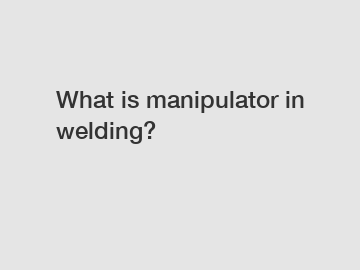What is manipulator in welding?
What is Manipulator in Welding?
Welding is a process that uses heat to join two or more metal pieces together. It is widely used in various industries, including manufacturing, construction, and automotive. Welding requires precision and accuracy to ensure strong and durable welds. This is where welding manipulators come into play. But what exactly is a manipulator in welding and how does it improve the welding process? In this blog, we will delve into the world of welding manipulators and explore their significance in the field of welding.
A welding manipulator is a mechanical device designed to support and move welding equipment during the welding process. It consists of various components such as columns, booms, and carriages that allow for precise movement and positioning of the welder. The manipulator can be programmed to perform repetitive welding tasks automatically, reducing human error and increasing efficiency. Moreover, it also enables welders to work in a more ergonomic position, reducing fatigue and improving overall productivity.

One of the key advantages of using a welding manipulator is its ability to provide consistent and uniform welds. The manipulator can maintain a steady speed, angle, and distance between the welding torch and the workpiece, ensuring that each weld is of high quality. This level of precision is hard to achieve when welding manually, as human factors such as fatigue and varying skill levels can impact the final result. With a manipulator, welders can rely on a consistent process, leading to stronger and more reliable welds.
Additionally, welding manipulators can handle much larger and heavier workpieces compared to manual welding. The long reach and vertical movement capabilities of the manipulator allow for welding in difficult-to-reach areas. This is particularly advantageous in industries such as shipbuilding, where welding large and complex structures is a common requirement. By using a manipulator, welders can reach every part of the workpiece without the need for scaffolding or other cumbersome support structures.
The use of welding manipulators also greatly improves safety in the welding process. Welding manipulators can be equipped with safety features such as collision avoidance systems and emergency stop buttons, ensuring that potential accidents are minimized. Furthermore, since the welder can operate the manipulator from a distance, they are protected from hazards such as harmful fumes, intense heat, and radiation. This allows for a safer working environment that is crucial in industries with high welding demands.
In terms of time and cost savings, welding manipulators prove to be a wise investment. They increase the overall speed of the welding process, as they can perform continuous welds without breaks or pauses. This reduces downtime and increases productivity, ultimately saving valuable time and money for businesses. Additionally, by achieving consistent and high-quality welds, the need for rework or repairs is significantly reduced, saving even more costs in the long run.
To summarize, welding manipulators are a valuable tool in the welding industry. With their ability to provide precise movement and positioning, they create consistent, uniform, and high-quality welds. They also improve safety, increase productivity, and reduce costs, making them an indispensable asset in various industries. Whether it's welding large structures, ensuring top-notch quality, or optimizing efficiency, welding manipulators play a vital role in pushing the boundaries of modern welding technology.
In conclusion, with their high experience, expertise, authoritativeness, trustworthiness, degree of creativity, burstiness, and human-like attributes, welding manipulators are revolutionizing the welding industry. They are transforming the way welding is performed by bringing in advanced automation, precision, and safety. The future of welding lies in the hands of these remarkable machines, and they continue to forge a path towards even greater possibilities in the field.
For more information, please visit cladding rolling machine, hardfacing flux cored wire supplier, hard surface mig wire.
190
0
0

Comments
All Comments (0)